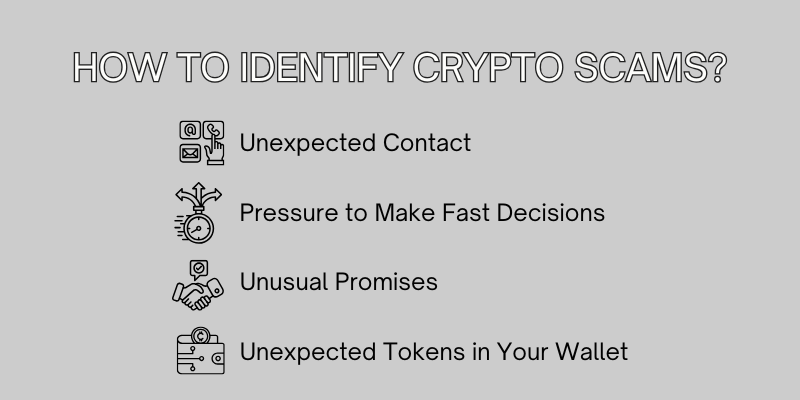Crypto scams have become a serious threat in cryptocurrency. The market offers great growth opportunities, but it also comes with risks, especially from scammers preying on unsuspecting investors.
In this article, we’ll uncover some of the biggest crypto scams in history, explaining how they worked and the financial damage they caused.
Biggest Crypto Scams
Below, we look at the biggest and most widely known scams in crypto history.
Rug Pulls
Rug pulls are among the most common crypto scams. In these schemes:
- Scammers launch a cryptocurrency project that appears legitimate. A well-designed website and strong marketing efforts often back it.
- Promises of groundbreaking technology or guaranteed high returns attract investors.
- After collecting substantial funds, the project founders disappear, leaving investors with worthless tokens.
Squid Game Token Scam (2021)
This project capitalized on the popularity of the Netflix series Squid Game. Promising exciting features and a gaming platform, the developers amassed millions of dollars. Within days, they vanished, stealing over $3 million in investor funds.

To protect yourself from rug pulls, avoid projects with unknown team members or unclear plans. Ensure trusted individuals securely manage the project’s funds to minimize the risk of scams.
Pump-and-Dump Schemes
- Scammers spread false or exaggerated information to artificially inflate a cryptocurrency’s price.
- The hype drives the price up, attracting eager investors who don’t want to miss out.
- Once the price peaks, the scammers sell their holdings, causing the value to crash and leaving late investors with big losses.
For example, Bitconnect (2017) operated as a lending platform, promising fixed investment returns. It inflated its token price through aggressive marketing and false claims. This attracted thousands of investors. In early 2018, the platform collapsed, causing billions of dollars in losses.
To spot pump-and-dump schemes, look out for coins with sudden price jumps that aren’t backed by real news or updates. Be wary of investment advice from unverified social media sources, as these are often part of such schemes.
Ponzi Schemes
- Scammers promise high returns to investors.
- Instead of making real profits, they pay these returns using money from new investors.
- The scheme falls apart when they can’t attract enough new participants, leaving many people with big losses.
For example, PlusToken (2018-2019) promised investors guaranteed returns, attracting over $2 billion. The organizers vanished with the funds, though authorities later caught some of them. Unfortunately, many victims were never able to recover their losses.
To avoid Ponzi schemes, be skeptical of investment opportunities that promise consistently high returns with no risks. Also, check if the project generates real revenue or relies only on new investments.
Biggest Crypto Scams in History Examples
Below, we explore the biggest crypto scams:
FTX Collapse (2022)
Once a leading cryptocurrency exchange, FTX collapsed due to alleged fraud by its founder, Sam Bankman-Fried. Misuse of customer funds led to a loss of billions of dollars. This case is a clear reminder that even platforms that appear reputable can collapse because of unethical practices.
OneCoin (2014-2017)
OneCoin is one of the largest crypto scams in history. It presented itself as a revolutionary cryptocurrency but later turned out to be a multi-billion-dollar Ponzi scheme. Its founder, Ruja Ignatova, remains one of the most wanted fugitives.
FTX Lawsuit Against Binance (2024)
FTX, the collapsed crypto exchange, filed a $1.8 billion lawsuit against Binance and its former CEO, Changpeng Zhao. The lawsuit claims a fraudulent share deal funded with stolen customer money.
MTFE Ponzi Scheme (2023)
Metaverse Foreign Exchange (MTFE) scammed investors out of over $1 billion. The platform promised profits from AI-driven crypto trading but was actually fabricating results before collapsing.
Celsius Network Fraud (2022)
Celsius Network, a major crypto lending service, paused all transfers and declared bankruptcy. An investigation revealed their business practices were “Ponzi-like,” impacting billions in customer funds.
FTX Collapse (2022)
FTX, once a leading crypto exchange, collapsed due to alleged fraud by founder Sam Bankman-Fried. Billions of dollars were lost after customer funds were misused.
Africrypt Scam (2021)
Africrypt, a South African investment platform, reported being hacked, but suspicions grew that the founders had stolen $3.6 billion worth of Bitcoin. The founders disappeared, leaving investors empty-handed.
OneCoin (2014-2017)
OneCoin is one of the largest crypto scams in history. It claimed to be a revolutionary cryptocurrency but later turned out to be a multi-billion-dollar Ponzi scheme. Its founder, Ruja Ignatova, remains one of the most wanted fugitives.
How to Identify Crypto Scams?
Now we share few tips, how to recognize a crypto scam:
Unexpected Contact
Be cautious if someone reaches out unsolicited with investment advice or offers. This can include:
- Phone calls, emails, or messages from unknown individuals claiming to be brokers or managers.
- Invitations from forums or social media groups promoting cryptocurrencies.
Scammers may also use fake endorsements to gain your trust. For example, celebrity promotions on social media that seem too good to be true or even recommendations from friends or family who have unknowingly fallen victim.

Pressure to Make Fast Decisions
Scammers often create a sense of urgency to stop you from thinking clearly. They may push you to transfer funds, pay fees, or download suspicious apps immediately. If you feel pressured to act quickly, it’s a major red flag.
Unusual Promises
Be wary of investment offers that sound too good to be true, like “guaranteed” returns or risk-free opportunities. Scammers often promise high rewards with little or no risk. Additionally, watch out for projects with missing or unclear whitepapers, as this can be a sign of a scam.
Unexpected Tokens in Your Wallet
If you notice tokens in your crypto wallet that you didn’t purchase, it could be a scam tactic. Scammers may send fake or unwanted tokens as part of a scheme to trick you into engaging with their scam.
How do Crypto Scams Operate?
Below, we explore how scammers use various tactics to deceive investors.
1. Fake Platforms and Wallets
These scams mimic legitimate platforms to steal user credentials or funds. Scam websites trick users into providing sensitive information like wallet keys or login details. Fake apps, disguised as legitimate crypto tools, often appear on official app stores briefly before being removed.
2. Fraudulent Tokens and ICOs
Scammers create fake Initial Coin Offerings (ICOs) to lure investors. They promote a promising new token, collect large sums of investment, and then disappear. Once liquidity is drained, the token’s value collapses, leaving investors with nothing.
3. Phishing Scams
Phishing emails or messages lead victims to fake websites designed to steal login credentials. The goal is to gain access to victims’ cryptocurrency wallets.
4. Employment Scams
These scams offer fake jobs where people are asked to open accounts or move money, without realizing they are helping with illegal activities.
Protecting Yourself from Crypto Scams
We share a few tips to help you stay safe and protect yourself from crypto scams.
- Only invest through well-known and regulated platforms.
- Avoid sharing your private keys or seed phrases with anyone.
- Double-check website URLs for authenticity.
- Verify the credibility of any investment opportunity through independent research.
What to Do If You’re Scammed?
If you suspect you’ve fallen victim to a crypto scam:
- Report the incident to local authorities and financial regulators.
- Share details of the scam with online crypto communities to raise awareness.
- Consider contacting legitimate crypto recovery companies that specialize in helping recover lost or stolen cryptocurrency.
- Reach out to legal experts specializing in digital asset recovery for further assistance.
Conclusion About Biggest Crypto Scams
The biggest crypto scams, like the FTX Collapse and the OneCoin Ponzi scheme, show that even well-known projects can deceive investors.
Cases such as the Africrypt scam and Celsius Network fraud highlight the importance of staying alert. To protect your investments, always be cautious, do thorough research, and use only trusted platforms.
FAQs About Biggest Crypto Scams
What are crypto scams?
Crypto scams are tricks used by scammers to steal your money or personal information. Common scams include fake investment platforms, phishing emails, and Ponzi schemes.
How can I spot a cryptocurrency scam?
Watch out for promises of guaranteed high returns, which are often signs of big crypto scams. Always research projects carefully, especially if they claim to be revolutionary or risk-free.
What are some of the biggest crypto scams in history?
Some of the biggest scams in crypto include the FTX Collapse and the OneCoin Ponzi scheme. These famous crypto frouds caused billions in losses and show how risky the crypto market can be.
How can I protect myself from crypto frauds?
Use regulated platforms, never share your private keys, and double-check all websites for legitimacy. Being cautious can help you avoid becoming a victim of crypto frauds.
What should I do if I’m scammed?
Report the scam to authorities and share what happened to warn others. Consider consulting a legal expert to recover losses from the largest crypto scams.